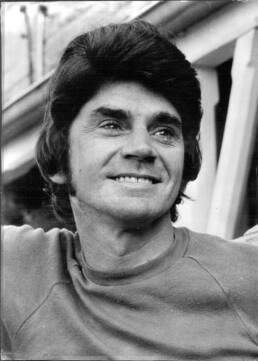These stories may contain descriptions of childhood trauma and abuse. Aboriginal and Torres Strait Islander people should be aware that this website may contain images, voices or names of people who may have passed away. If you need help, you can find contact details for some relevant services on our support page.
Aboriginal Australian actor, teacher, film director and activist, Brian Syron (1934-1993), was in kinship care and an institution during his childhood. Brian Syron was born in Balmain, Sydney to Daniel Syron, a Biripi (also known as Birpai) man from New South Wales and Elizabeth Murray from Newcastle-upon-Tyne in England. He was the fifth of eight children.
During his childhood, Brian learned about his Aboriginal heritage by living with his paternal grandmother at Karuah, 184 km north of Sydney, for long chunks of time.
When he was fourteen, Brian ended up in the Grafton Correctional Centre.
By the age of twenty-two, Syron had become a male model and began studying acting at the Ensemble Theatre Company in Sydney. He studied with Hayes Gordon and fellow students were Jack Thompson, Reg Livermore, and Jon Ewing.
When he was twenty-seven, Brian Syron left Australia and studied acting with Stella Adler in New York. Fellow students included Warren Beatty and Robert de Niro.
I must confess that as a Redfern blackfella when Brian first told me this story about who some of his classmates had been during his time in New York, I was both impressed and sceptical… my scepticism was only resolved when Robert de Niro later visited Australia and we realised Brian’s story was true (Foley).
Syron later co-founded a theatre company in Saratoga Springs in New York and did a number of tours throughout the country, including through the southern states where segregation prompted him to direct his attention to Aboriginal issues in Australia.
Back in Australia, Brian Styron taught Aboriginal actors, including Denis Walker, Gary Foley, Jack Davis, Maureen Watson, and Hyllus Maris.
In addition:
During the late seventies and early eighties Brian had held acting classes in a small studio on William Street in Darlinghurst, Sydney. He boasted such students as Helen Morse, John Hargraves, Lydia Miller and Rhoda Roberts. Brian’s speciality was the ‘American Method’ he learnt from his acting teacher Stella Adler (Foley).
In 1992, Jindalee Lady was released. The film, about an Aboriginal Australian woman who is a successful fashion designer, primarily employed Aboriginal Australians as cast and crew and enjoyed some success internationally.
Brian Syron is widely recognised as a pioneer of Aboriginal theatre, a passionate advocate for his people, and as “a great teacher and actor” (Fischer).
References:
Foley, Gary. “Brian Syron – Forgotten Aboriginal Hero of Theatre.” Victoria University Research Repository, (2013). https://vuir.vu.edu.au/25899/
Gerhard Fischer, “Syron, Brian Gregory (1934-1993).” Indigenous Australia. https://ia.anu.edu.au/biography/syron-brian-gregory-27637
Syron, Liza-Mare. “An Actor Prepares: what Brian told me.” AustralianPlays.org, 2011. https://apt.org.au/assets/files/resource/doc/2012/02/BlakStage_Essay_AnActorPrepares.pdf
Image available here.
